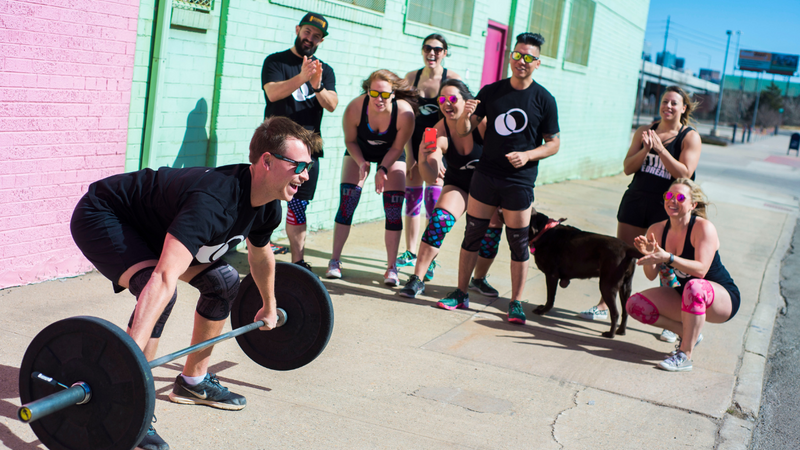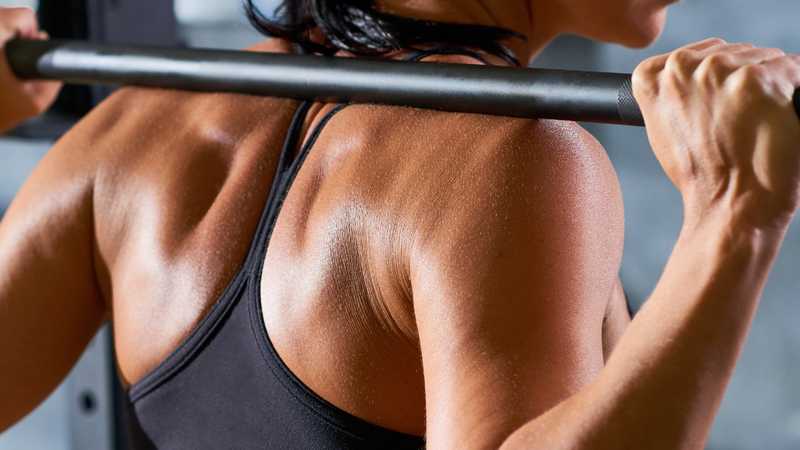Written By Malia Warren
You've been doing CrossFit for a little while now.
You know what some of the movements are (you still can't understand why they have to call it a Snatch), not quite sure if you're doing the moves right, but you're having fun, and you want to get more serious.
These guys are walking into the gym with tons of equipment: their own jump ropes, wrappy thingy's for their wrists and hands, some weird looking shoes with a heel of some sort?

Then you've got these people, about half your gym, wearing knee things. Some are boring colors, and make you wonder if you should be protecting your knees too.
Yes. Yes, you should.
Whether it's through correct, perfect form, stretching or wearing knee sleeves, you should always aim to protect your body from injuries or overtraining.
But, like, why Knee Sleeves?
Well, here is your guide to the why behind the sleeve.
This is a common question we get at our events: Do I REALLY Need Knee Sleeves?
If you're doing CrossFit, weightlifting, or any other strenuous activity where you're putting more strain on your knees, then it isn't a bad idea to use them.
They provide Mild to Moderate Compression to your knee joint, which provides support, warmth, and stability.
"A knee brace is usually worn to stabilize a weak or injured knee by controlling what plane the joint complex moves in", says our friend, USA Weightlifting Coach, Mark Lind .

In addition, a brace of this kind also adds compression. This can keep the knee warm and help limit swelling of the joint during activity.
"A doctor or physical therapist may prescribe a knee brace to correct or compensate for an issue their specific patient has" says Mark.
Say it with me friends, Knee Sleeves should not be used to cover up knee pain.
Stiffness in your knee muscles, occasional runners knee, etc.-- those are all legitimate reasons why knee sleeves would benefit you.
But again, using them, because you have knee pain, that persists when you are not working out, is only going to mask a recovering injury.

The last thing you want to do is cover up a more serious injury. Not only will it make things worse, it'll derail future training plans as well!
Often caused by a muscular imbalance around the knee, outer hips or a mobility deficiency in the hips or ankles -- knee pain is a reason to seek medical opinion from a professional coach, doctor, or physical therapist (or all 3).
Using Knee Sleeves when squatting, for example, will provide compression, which can help limit swelling during activity to a small degree if you have a mild overuse injury.
This compression can also provide some proprioceptive help to your brain, which should make you more aware of your movement quality.
Ok, smaller words.

"Limiting swelling through mild compression can also reduce wear and tear because swelling increases friction, which can lead to more irritation and swelling." says CrossFit Level 1 Coach, Mark.
Of course, “doing it right” is your highest priority goal as a barbell athlete, but knee sleeves can actually provide some assistance.
They can actually help you move better and mitigate some of the effects of less than perfect mechanics while you train.
This compression can help you move better and keep your knees warm, but knee sleeves do not provide maximum compression the way Knee Wraps do.
Knee wraps look like a very long and strong elastic bandage, and you wrap them tightly around the knee joint. They provide an additional performance benefit as compared to knee sleeves because they store potential energy in them while the lifter is descending into the bottom of a squat.
This stored energy is given back to the lifter as kinetic energy as the lifter ascends out of the bottom of a squat or deadlift. That is, they increase performance!
On the descend, compression and warmth work as a team with the elasticity of the knee wrap to store energy (like a loaded spring) making the load on the knees feel more springy
They are meant to fit so tight, they interfere with circulation, restrict movement and cause significant irritation if used in high volume squatting, running, jumping, or any other work that requires rapid full range movement.
They are also somewhat of a hassle to put on and take off, but they come loose easily. We only recommend using knee wraps if you are familiar with their usages or if you can seek advisement from a coach on how to properly use them during lifts.

That's a Wrap.
Knee sleeves are ideal for sports like CrossFit, bootcamps or other sports that mix modalities like running and jumping with weightlifting in workouts.
You'll find that knee sleeves are actually very popular and have a diverse use, even in the fields of trades such as construction and more.
And YES, they will smell like a wetsuit: that's the neoprene. Neoprene gives you the heat conduction that knee sleeves are useful for!
Some other uses for knee sleeves include: lunges, burpees, and box jumps, and if you pull them down over your shins during rope climbs you won't ever have to worry about rope burn on your legs again!
With so many versatile uses, it's easy to see why you knee-d (get it!?) a pair of knee sleeves in your gym bag.

Size Matters.
With so many options available, it's most important to make sure that your size is right the first time!
When they get loose to the point where you're constantly pulling them up, or adjusting them during a working, you'll know it's time to say goodbye to your trusty old friend.
Knee sleeves should be sized in order to not bind at maximum knee flexion, and they should never restrict circulation in any way. They should also be loose enough so you can remove them without too much of a fight. The fit should also be tight enough not to be slipping from where you position them.
You can find your perfect fit by following our detailed sizing chart here or visiting us at one of our future events, where we are more than happy to get you sized up.
Buyer beware: your sleeves may stretch minimally with use, which is why we recommend the tighter fit if you're in between sizes.
You can expect to replace your knee sleeves every 6-12 months depending on the frequency of use.
Wear Your Heart On Your Sleeves
At Lifting the Dream, we're proud to offer some of the most unique designs on the market!
Our knee sleeves are made with top-quality materials to improve athlete function but are also designed to reflect personal style. Donuts? Mermaids? Damn straight.
Check out our newest compression knee sleeves designs to find your perfect style, including our newest Contour Knee Sleeves.
If you have any questions or you would like to be a guest blogger, please email us at blog@liftingthedream.com
Have you tried Knee Sleeves before? What is your favorite thing about them?
 |
Malia is the force behind Lifting the Dream and a proud mompreneur. When she's not lifting heavy weights, she's probably at the beach or Disney with her family. She is a Cali girl born and raised, with salt water in her veins and sunshine in her heart. She and her family now reside in Florida soaking up the sun, heat, and all the amazing outdoor activities this state has to offer. |





0 comments